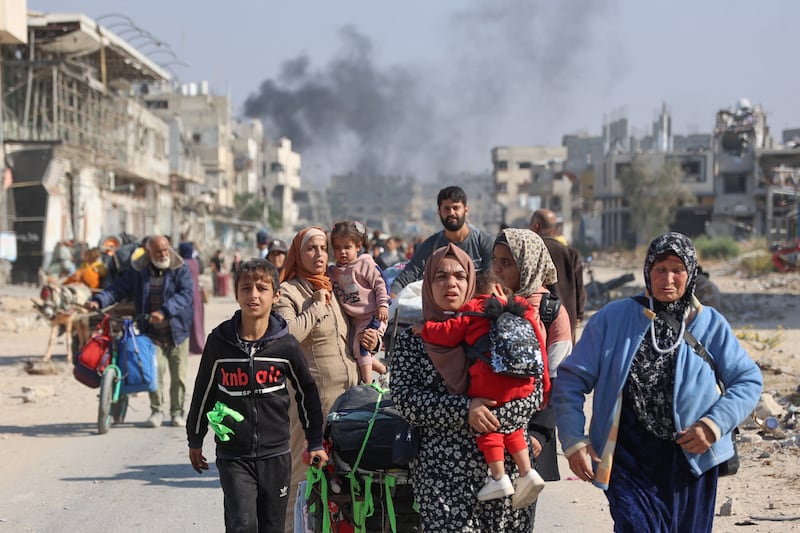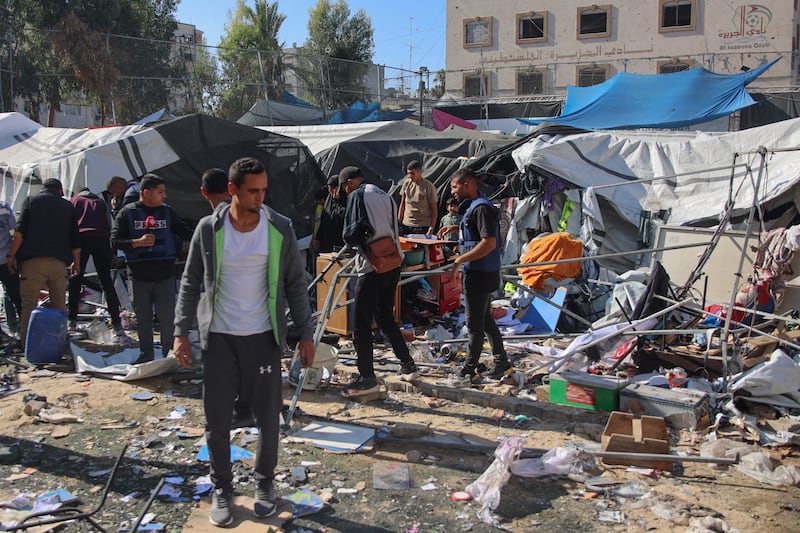When Israeli forces first swarmed into the Gaza Strip last year they targeted north Gaza, an area stretching across densely packed urban centres and small strawberry farms near the border with Israel.
The military said hardened Hamas fighters were hiding among the civilians there, so it struck residential neighbourhoods, hospitals and schools turned shelters. It was one of the deadliest moments of the war.
Now, almost exactly a year later, it is all happening again. North Gaza is the centre of a renewed Israeli offensive that over the past five weeks has unleashed some of the Israeli military’s most devastating attacks yet. In an effort to stamp out what the military has called a Hamas resurgence, troops, tanks and armed drones have hammered the area almost daily, displacing 100,000 residents and killing likely more than 1,000 others, according to the United Nations. (Those statistics do not distinguish between civilians and combatants.)
There are so many corpses, multiple residents and a local doctor said, that stray dogs have begun to pick at them in the streets.
“Life over the past four weeks, if I can sum it up, is a people being exterminated,” said Islam Ahmad (34), a freelance journalist from north Gaza who described helping bury neighbours in a mass grave.
The return of fighting to the northernmost reaches of Gaza shows how Israel’s approach has led to a bloody carousel of sorts, with the Israeli military chasing Hamas fighters in circles – and civilians often caught in the crossfire.
Two Israeli security officials compared it to cutting the grass, using a phrase that has circulated among Israeli officials for years, including prime minister Benjamin Binyamin Netanyahu. Each time Hamas cells regrow, they say, Israeli forces will come back to cut them down.
This sort of cyclical combat reflects Israel’s murky strategy in a war now in its 14th month. Israel has eliminated much of Hamas’s senior military leadership, killed thousands of its fighters and collapsed many of its tunnels – yet Israel has shown no sign of letting up.

That is in part because Israeli forces have avoided holding much ground and Netanyahu has not committed to a viable postwar plan. Hamas has filled the resulting power vacuum.
North Gaza is the northernmost of Gaza’s five governorates, just north of Gaza City. Israeli forces left after pummelling the region last year. In May they returned for an intense bout of fighting and recovered the bodies of seven hostages seized in the Hamas-led October 7th, 2023, attack on Israel. Then they left again. Hamas fighters regrouped, and now, once more, the military is back.
The goal this time is to isolate Hamas fighters in north Gaza from others in Gaza City, according to a senior Israeli security official who spoke on the condition of anonymity to describe military tactics. Israel captured 500 suspected Hamas fighters and killed another 750 in north Gaza last month, the official said. He said the military had encouraged civilians to evacuate but did not track civilian casualties. He said forces planned to remain for at least another month.
Gadi Shamni, a retired general who once commanded Israeli forces in Gaza, said full occupation would demand tremendous resources, but the current approach was a temporary fix, with ugly consequences for residents.
“As soon as you evacuate those alleys and streets Hamas will regain control immediately,” he said. “The main problem here is that the government of Israel, and Netanyahu himself, is trying to bypass the real solution of finding an alternative to Hamas” to govern Gaza.

The situation on the ground, by some measures, is even more dire than a year ago. Infrastructure is crumbling, humanitarian aid is severely restricted, and many emergency workers and aid groups have left. On Friday, a UN-backed panel said famine was likely “imminent” within northern Gaza.
The Palestinian Civil Defence, an emergency service run by Hamas’s interior ministry, said it had officially halted rescue operations in the region last month because of the intense threat.
The Palestinian Red Crescent, one of the few aid groups still operating there, said no ambulances could reach the hardest-hit parts of north Gaza. When a woman recently called for rescue after a relative lost a limb the dispatcher provided instructions over the phone on how to treat the amputation, a spokesperson said.
Hosam Al Sharif (46), a father of four in Jabalia, said that at the start of the latest siege, help was available. Now, he said, people with “any minor injury will bleed until they die”.
Hospitals are also teetering, leaving many treatable patients to die. On October 30th, Dr Hussam Abu Safiyah, the director of Kamal Adwan Hospital in Jabalia, issued an urgent plea saying the hospital lacked surgeons but had multiple victims needing surgery.
Over the next five days, the hospital was bombed three times, according to Abu Safiyah. Gaza health officials said Israeli forces had bombed the hospital. The World Health Organisation said one Israeli strike had destroyed medical supplies it had delivered just days earlier.
The Israeli military said in a statement that it had not bombed the hospital. In one case, the military said, it struck a target about 100m from the hospital. In another it blamed an explosive device planted by militants. In a third case it said it had no information. Hamas exploits civilians “by embedding terror infrastructure within, beneath and near sensitive sites, as in this case with the Kamal Adwan Hospital”, the statement added.
Abu Safiyah told the New York Times last week that the hospital’s staff was still besieged. “We urgently appealed to the world, international and humanitarian organisations,” he said. “We didn’t get a response.” He said he did not witness militants in the hospital but would treat any victim.
The UN has said that Israel has cut off nearly all humanitarian aid to north Gaza. A US deadline for Israel to allow more aid expires this week.

Ahmad, the journalist, said north Gaza had been relatively calm for months. Then fighting exploded again in October.
On October 29th, he said, he heard a loud explosion before dawn. When he went to investigate the street was littered with mangled bodies, he said.
The Israeli military said it had bombed a five-storey building because forces had spotted a militant on the roof. There were also, according to local officials and residents, dozens of families sleeping inside. The Gaza health ministry said 93 people were killed, including many children. The Israeli military disputed that number.
Ahmad, who took photographs of the aftermath for Agence France-Presse, said he had also counted 93 bodies as they were carried on donkey carts to a mass grave. “We stacked every three bodies on top of one another,” he said. “We don’t have the luxury of honouring the dead.” They lacked enough sand, he said, so they laid tiles on the grave to keep the dogs out.
Fewer than 95,000 people remain in the region, a fifth of its pre-war population, according to the UN, Israeli officials said there are far fewer. The relentless bombing has fuelled fears among Palestinians that Israel is intent on depopulating northern Gaza permanently.
Since the start of the war Israel has urged Palestinians in Gaza to migrate south for their safety – even though it has also repeatedly bombarded the south. The Israeli government has acknowledged having studied a plan put forth by a prominent former general to expel the remaining 400,000 people in the broader northern Gaza region and force Hamas to surrender there by cutting off food and water.
Gideon Saar, Israel’s foreign minister, said on Monday that residents could return to northern Gaza after the war.
In Beit Lahia, a farming community, residents were trying to rebuild earlier this year. Yousef Abu Rabee, a farmer, returned in February to plant crops to feed his neighbours, including eggplant, squash and fava beans. An American farmer helped him raise $90,000 (€85,000). He provided seedlings to 50 farms and posted videos to Instagram showing him and others sowing fields, including in craters left by missile strikes.
“We’re trying to grow food on our land, or what is left of our land, in order to save ourselves and our fellow people in the north,” he said in a video posted last month. Several days later another video showed the fruits of his work: a field of sprouting crops.
About a week later, according to a family member and a friend, he was killed in a strike. – This article originally appeared in The New York Times
2024 The New York Times Company



















